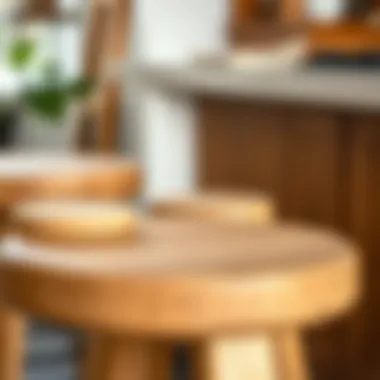The Charm of Unfinished Counter Stools in Design


Intro
Unfinished counter stools stand at the crossroads of functionality and design, embodying a unique blend of simplicity and elegance in a modern home. These stools, often crafted from raw wood or metal, carry an inherent adaptability that speaks to a variety of interior themes—from rustic farmhouse ambiances to sleek urban lifestyles. With their unrefined allure, unfinished counter stools allow for a personal touch, inviting homeowners and designers alike to add their unique flair.
Their importance in contemporary interior design lies not just in their aesthetic appeal, but also in their practical applications. As more people seek to curate spaces that reflect their individual tastes, the demand for versatile furniture options, such as unfinished counter stools, is on the rise. This guide provides a thorough exploration of the various aspects of unfinished counter stools, including their materials, design styles, and maintenance practices.
Furniture Trends
Current Market Trends
In recent years, there’s been a significant shift in consumer preferences toward sustainable and eco-friendly products. Many are drawn to the notion of unfinished wood, which not only brings a natural vibe to any setting but is also often sourced from responsibly managed forests.
The market has seen an upswing in designs that emphasize minimalism and functionality. Unfinished counter stools fit nicely with this trend, enabled by their clean lines and unobtrusive presence. The growing interest in DIY culture has also propelled their popularity; many consumers are eager to personalize their furniture, making these stools an appealing choice for those who enjoy creativity in home decor.
- Rise of Eco-Conscious Choices: Many buyers now prioritize sustainable materials.
- Minimalistic Designs: Unfinished stools are often simplistic yet elegant, aligning with current décor preferences.
- DIY Enthusiasm: There’s a pronounced interest in customizing and personalizing furniture, driving the demand for unfinished pieces.
Popular Styles and Designs
The beauty of unfinished counter stools lies in the myriad of styles they encompass. Here are some of the more popular designs that continuously enjoy favor among buyers:
- Rustic Farmhouse: Characterized by a rugged finish and often featuring reclaimed wood, these stools are perfect for a warm, inviting space.
- Scandinavian Minimalism: Clean lines and functional simplicity define this style, using light woods to enhance open spaces.
- Industrial Charm: Combining raw metal with rustic wood, these stools exhibit an edgy aesthetic ideal for loft-style environments.
These styles not only serve as seating but often act as significant decor pieces, adding a distinct flavor to the surrounding area. Consumers can mix and match styles to create an eclectic design that suits their personal tastes.
"Unfinished counter stools provide a canvas for creativity, allowing homeowners the freedom to shape their spaces as they see fit."
DIY Projects
Step-by-Step Guides
For those inclined to take matters into their own hands, unfinished counter stools offer ample DIY opportunities. Here’s a basic guide to customizing a stool to match your decor:
- Choose Your Finish: Whether you prefer staining, painting, or simply sealing your wood, decide on a finish that complements your décor.
- Prep the Stool: Sand the surface lightly to ensure even application and better adhesion of paints or stains.
- Apply Your Finish: Using brushes or cloth, apply your chosen finish in even strokes, allowing adequate drying time between coats.
- Seal for Protection: Apply a clear sealant to protect against wear and tear, enhancing durability against spills or scratches.
- Add Personal Touches: Consider adding cushions or decorative seat covers for an added layer of comfort and style.
Budget-Friendly Ideas
Customizing unfinished counter stools doesn’t have to break the bank. Here are a few economical strategies:
- Use remnants or leftover paint and stains from previous projects.
- Look for inexpensive fabrics on sale to create unique seat covers.
- Explore local thrift shops for accessories that can elevate the overall look without costing much.
This blend of personalization and resourcefulness amplifies the charm of unfinished stools while ensuring they remain budget-friendly. As homeowners and designers harness the transformative power of these stools, they open the door to endless possibilities in both style and function.
Foreword to Unfinished Counter Stools
Unfinished counter stools stand as unsung champions in the realm of interior design. While many may overlook their aesthetic potential, these pieces bear versatility and charm that can elevate any space. Not solely a seating solution, they meld practicality with artistic opportunity, offering a canvas for creativity. This article explores the multiple dimensions of unfinished counter stools, making a case for their role in modern decor and beyond.
Definition and Characteristics
Unfinished counter stools are typically made from raw wood without protective staining or varnish, allowing homeowners and designers to personalize their surfaces. These stools often come in various heights, sizes, and ergonomics suited for comfortable use at counter-height surfaces. One defining characteristic is their adaptability; they can be stained, painted, or left natural to fit specific design aesthetics.
Moreover, their minimalist construction lets them fit seamlessly into both contemporary and traditional environments. Whether you prefer a rustic farmhouse look or a sleek modern vibe, unfinished stools adapt accordingly. They hailed as functional assets, these stools can double as decorative elements, showcasing craftsmanship while offering a unique touch to dining and kitchen spaces.
Key characteristics include:
- Raw Wood Finish: Unfinished surfaces can highlight the natural grain and texture, mere wood waiting for some love.
- Customization: You can easily tailor these stools through refinishing or painting to suit your space's needs.
- Durability: While raw, these stools often feature sturdy construction designed to withstand daily use.
Historical Context
The journey of unfinished counter stools traces back to pre-industrial furniture-making when artisans crafted pieces by hand. Their simplicity resonated with the idea of functional beauty, a trend wherein furniture was designed to serve a purpose without unnecessary frills. Fast forward to the modern epoch, the surge of DIY movements spurred an admiration for raw, unfinished designs.
Scandinavian design, championing minimalism and simplicity, played a substantial role in popularizing unfinished pieces. The idea of embracing natural materials reflects a cultural shift towards sustainability, which speaks to contemporary values. Now, unfinished counter stools embody this ethos, drawing connections between the past and present while providing a tactile experience that polished furniture simply doesn’t offer.
Moreover, as consumers increasingly opt for eco-conscious choices, the demand for unfinished pieces has gained traction. These stools not only exude a rustic charm but also complement various design sensibilities, aligning with values surrounding sustainability and individual expression. Put simply, they are more than just seating options; they embody a lifestyle and philosophy in furniture selection.
Design Versatility


When considering interior furnishings, especially for spaces like kitchens and dining areas, design versatility plays a crucial role in not just aesthetics but functionality as well. Unfinished counter stools stand out in this regard, offering a remarkable balance between style and adaptability. Their ability to complement a variety of settings—from sleek modern ensembles to rustic countryside homes—makes them a popular choice among homeowners, renters, and designers.
Modern vs. Traditional Styles
In the realm of interior design, style compatibility is vital. Unfinished counter stools are a chameleon of sorts, able to adapt to both modern minimalism and traditional charm.
- Modern Styles: Think clean lines, open spaces, and a hint of industrial flair. In contemporary settings, unfinished counter stools can be left in their raw state for a raw, edgy vibe. Adding metal accents can enhance this look, making spaces feel more cohesive.
- Traditional Styles: Here, the beauty of unfinished wood shines through. When integrated into classic designs, these stools can evoke warmth and familiarity. A quick stain or a touch of varnish can transform them, ensuring they fit seamlessly with vintage decor.
This versatility extends to their shapes and designs. Round, square, backless, or with backs—there’s a style to fit every taste and need.
Eco-Friendly Considerations
In an age where sustainability is paramount, the choice of unfinished counter stools aligns well with eco-conscious living. Using these stools means reducing the demand for fully finished products, which often involve chemical treatments or synthetic finishes. The appeal is not just aesthetic but ethical.
- Less Chemical Exposure: Unfinished stools often contain fewer harmful chemicals, making them an excellent option for families aiming to create safe living environments.
- Sustainable Sourcing: Many manufacturers prioritize sustainable wood sources. If you love to breathe life into old materials, consider reclaimed wood stools. Not only do they reduce waste, but they also add rich history to your space.
Choosing unfinished counter stools means opting for a more environmentally friendly piece, reflecting personal values in your home.
Sustainable Materials and Practices
The materials used in crafting unfinished counter stools reveal much about their ecological footprint. It’s not just about using wood; it's about which type you choose and how it’s sourced.
- Wood Varieties: Popular choices include oak, maple, and walnut, each offering unique attributes. Oak is sturdy and resistant to wear; maple is durable but lighter in tone, while walnut features rich hues that stand out.
- Responsible Sourcing: Look for certifications like FSC (Forest Stewardship Council) to ensure the wood is harvested sustainably.
- Biodegradable Finishes: For customization, consider non-toxic, biodegradable finishes that minimize environmental impact.
In all these ways, choosing unfinished counter stools can significantly reflect a commitment to sustainable living without sacrificing style or quality.
Overall, the design versatility of unfinished counter stools not only caters to diverse tastes and preferences but also embodies a smarter, eco-conscious approach to home decor. With their ability to adapt, shine, and serve practical needs, these stools represent a perfect marriage of style and function.
"Versatility lies not just in appearance, but in the essence of adaptability and sustainability that unfinished counter stools bring to the home."
Materials Used in Unfinished Counter Stools
Unfinished counter stools are more than just simple pieces of furniture; they can reflect personal style, practicality, and sustainability. The materials used in their construction play a pivotal role in determining their overall aesthetic, durability, and comfort. When selecting stools, understanding the various materials available and their unique properties becomes essential for homeowners and designers alike.
Wood Varieties and Their Properties
Wood stands as a classic choice for unfinished counter stools, blending warmth with versatility. Different types of wood come with distinct characteristics that can influence both the stool's look and feel. Here are some wood types commonly used:
- Maple: Known for its durability and fine grain, maple offers a smooth surface that takes stain beautifully. Its hardness makes it resistant to dings and scratches, suitable for high-traffic areas.
- Birch: Birch is light yet strong, often characterized by its pale color. It's easy to work with, making it a popular choice for DIY enthusiasts looking to customize their stools.
- Oak: Recognized for its robust nature, oak provides great structural integrity. The pronounced grain adds character, making each piece unique. Oak can be stained in various shades while still showcasing its iconic texture.
- Pine: This softwood is cost-effective and readily available. Its light weight makes it easy to move around. However, being softer, it may not hold up as well in heavy-use situations.
Selecting the right wood type not only enhances the appearance of the counter stools but also impacts their longevity and ease of maintenance.
Metal and Other Combinations
While wood shines in popularity, metal and other materials bring a modern twist to unfinished counter stools. Combining materials can lead to striking aesthetic contrasts and functional advantages.
- Metal Frames: Incorporating metal as a frame material adds strength and stability. Options like stainless steel or wrought iron create a contemporary vibe. Their sleek profiles can suit a variety of kitchen styles, from industrial to modern chic.
- Wood and Metal: Many designs blend wood seats with metal bases, offering a mix of warmth from wood and the cool, solid feel of metal. This combo not only enhances aesthetics but also improves durability, giving designers room to play with styles.
- Upholstery: On occasion, you might find stools with a soft cushion paired with metal or wood. Fabrics can range widely from leather to canvas, opening up a world of possibilities for texture and color. Upholstered seats enhance comfort, making stools inviting for long chats around the kitchen counter.
Materials shape the usability and appeal of unfinished counter stools. By understanding the varieties of wood and the innovative mixes involving metal or upholstery, one can make informed choices that reflect their personal taste and meet functional needs.
"Choosing the right materials for your unfinished counter stools is akin to laying the foundation of a sturdy house: it determines the durability and the aesthetic appeal that will stand the test of time."
In an ever-evolving design landscape, embracing these materials not only preserves craftsmanship but also allows for endless customization opportunities.
Functional Benefits
When it comes to unfinished counter stools, one cannot overlook the multitude of functional advantages they bring to the table—both literally and figuratively. These stools are not just simple seating options; they serve as a crucial element in creating a comfortable, stylish, and practical dining or kitchen environment. Understanding these benefits can guide homeowners, designers, and DIY enthusiasts in making informed decisions when selecting and customizing their furniture.
Comfort and Ergonomics
Comfort plays a paramount role in the design of any seating furniture, and unfinished counter stools are no exception. An ideal stool should not only provide a place to sit but also ensure that the user feels at ease, whether they are enjoying breakfast or engaging in a long conversation with friends.
An unfinished counter stool can be tailored to fit individual needs, allowing for adjustments in height and design that support ergonomic seating. When choosing a stool, key design features to consider include:


- Seat Height: Make sure it aligns well with your counter height. A typical counter stool should have a seat height of around 24 to 26 inches for standard counter heights.
- Seat Depth and Width: A deeper seat often allows for a more comfortable experience, particularly if you plan on spending extended periods sitting.
- Back Support: While some may prefer the minimalist look of backless stools, those with backrests can provide added comfort and support, reducing strain on the spine.
Incorporating supportive cushions or upholstery options into unfinished stools enhances comfort further. DIY enthusiasts can easily add foam padding and fabric covers to suit personal preferences, making every sit a pleasurable one.
Durability and Longevity
Durability is another significant factor when considering unfinished counter stools. Made from a variety of materials and with a range of construction methods, these stools can withstand the test of time when properly cared for.
- Material Choice: A solid wood stool, like oak or maple, is typically much sturdier than one made from softer woods or particleboard. Unfinished stools made from hardwood tend to resist scratches and dents, ensuring they look good for longer.
- Construction Quality: Sturdily constructed stools using methods like mortise-and-tenon or dowel joinery provide better durability over time compared to those assembled with screws or nails that may loosen.
"Investing in high-quality materials and craftsmanship can turn a basic stool into a family heirloom."
Regular maintenance is also essential for ensuring longevity. Sealing unfinished wood with a protective finish, such as polyurethane or a natural oil, can help safeguard against moisture, stains, and general wear and tear. Proper care not only maintains the appearance of your stools but also extends their life, making them a wise investment in your home.
By understanding the functional benefits of unfinished counter stools—from optimizing comfort through ergonomic design to ensuring lasting durability with smart material choices—homeowners and designers can create spaces that are both attractive and practical.
DIY Customization Opportunities
Customization is the name of the game when it comes to unfinished counter stools. Not only do these pieces offer a blank canvas to express your individual style, but they also allow you to tailor functionality to your specific needs. Whether you’re aiming for a rustic vibe or a clean modern look, the options are bountiful. This section delves into finishing techniques and personal touches that can enhance both the aesthetic and utility of your stools.
Finishing Options and Techniques
Staining vs. Painting
When considering how to complete your unfinished counter stools, the crucial decision between staining and painting comes into play. Staining acts as a way to highlight the natural wood grain, enriching its beauty while providing depth. It's especially beneficial for those who appreciate a more rustic or natural appearance. One unique aspect of staining is that it allows the imperfections of the wood to show, adding a layer of character to the piece.
On the flip side, painting offers a world of colors. It’s perfect if you're aiming for a bold statement or want to match your stools to existing decor. Painting can also provide a more uniform and contemporary look compared to staining. One disadvantage of paint, however, is that it might chip over time and requires a more careful application process.
In weighing these options, think about where the stools will be placed and the overall effect you aim to achieve in your space.
Sealing for Protection
Once your counter stools have the finishing touches, it’s time to think about protection. Sealing is a non-negotiable step to ensure your handiwork lasts. A good sealant not only enhances the finish but also offers a layer of defense against spills and scratches. This key characteristic helps maintain the look you've crafted and is particularly important if your stools see heavy use.
There are various types of sealers available, from water-based to oil-based, each with its unique features. Water-based sealers tend to dry faster and have lower fumes, but may require more frequent reapplication. Oil-based sealers provide a durable finish, though they can take longer to dry and often have stronger odors.
Finding the right balance between aesthetic appeal and practical protection is essential for maintaining your stools' appearance for the long haul.
Adding Personal Touches
Upholstery Ideas
Adding upholstery to your unfinished counter stools opens up a whole new realm of possibilities. Whether you choose a vibrant fabric that pops or a more subdued tone for a sophisticated look, upholstery can enhance comfort significantly. This characteristic makes these stools not only beautiful but also conducive to enjoyment during long gatherings.
You might want to consider materials that are easy to clean, especially if children or messy eaters frequent your space. Foam cushions underneath can also elevate comfort, transforming the bare wood seat into a cozy perch.
While upholstery adds style, keep in mind it may require a bit more maintenance than bare wood, especially with regard to cleaning and potential repairs over time.
Decorative Accessories
Finally, don’t overlook the impact of decorative accessories. Thinking creatively about how to accessorize your stools can make all the difference in their visual appeal. From striking cushions to coordinating footrests, these elements can set the tone for your entire space.
Incorporating small touches like coasters or custom seat covers can reflect your personality and keep your stools looking fresh. One unique angle is the use of personalized initial embroideries on cushions, making them a standout in your decor.
However, be mindful that accessories should enhance—not clutter—your space. Striking a balance between simplicity and decoration is key.
"True personalization of furniture is all about expressing who you are, so embrace the opportunity to make these stools uniquely yours."
Ultimately, DIY customization opportunities with unfinished counter stools offer not just a chance to beautify your home but also serve as an engaging project that can be fun to navigate. The blend of creative finishing, protective sealing, and clever accessorizing culminates in a set of stools that are distinctively tailored to your taste and lifestyle.
Choosing the Right Unfinished Counter Stools
Selecting the appropriate unfinished counter stools is pivotal for achieving both functionality and aesthetics in your space. This choice can influence not only your room's visual appeal but also the comfort of those who use them. A well-chosen counter stool can effortlessly enhance the overall feel of a kitchen island or a bar area, making it more inviting for guests or family members. Moreover, the myriad of options available allows you to tailor your choices to fit your unique needs.
Sizing and Measurement Considerations


Size matters when it comes to unfinished counter stools. Before making a purchase, it’s essential to consider the specific dimensions of the space where the stools will reside. Measure the height of your counter or bar top to determine the required seat height. Generally, a stool should provide a gap of about 10-12 inches from the seat to the bottom of the counter for comfort and ease of movement.
It’s wise to account for the width of the area as well; squeezing in too many stools can lead to an awkward seating arrangement. A tip is to aim for at least 6 to 8 inches between the edges of the stools. This spacing grants sufficient room for diners to get in and out without knocking elbows.
"Choosing the right size is like finding a golden ticket; it transforms your space into a cozy haven."
In some cases, adjustable-height stools can be a lifesaver, especially in multi-use areas. They allow you to adapt the seating to fit your needs, be it for dining, working, or casual gatherings. Think about how the stools will be used. If they're for everyday family meals, comfort is paramount. But if they’re for entertainment purposes, style might take precedence.
Style Matching with Existing Decor
Another integral aspect of selecting unfinished counter stools involves harmonizing them with your decor. The design style of your stools should reflect or complement the existing aesthetic of your environment. Consider the materials, colors, and overall vibe of the space. For example, if you have a rustic or farmhouse theme, wooden stools with a natural or distressed finish will blend seamlessly. Conversely, sleek metal or modern stools will suit contemporary settings better.
Color compatibility is another crucial factor. An unfinished stool can often be customized, but keep in mind the overall color palette of your space before diving into personal touches. A fresh coat of paint or stain can tailor the stool's appearance, yet the base color should harmonize with surrounding elements.
When unsure, here are some points to ponder while matching styles:
- Materials: Wood, metal, or a combination?
- Color: Neutral tones can accommodate varied styles, while bold hues offer a statement.
- Design: Sleek and simple for modern, ornate for traditional.
In essence, thoughtfully considering size and style alignment is key to choosing the right unfinished counter stools. By focusing on these elements, your selection will not only serve practical purposes but will also elevate the aesthetic appeal of your space.
Maintenance and Care
An essential aspect of owning unfinished counter stools is understanding how to properly maintain and care for them. Unlike finished stools, which often come with a protective coat, unfinished models require ongoing attention to both preserve their natural beauty and ensure their longevity. Regular maintenance not only keeps these pieces looking their best but also enhances their functionality, making them durable seating options. By incorporating a consistent care routine, you can prevent dirt accumulation and the wear that typically occurs with everyday use.
Cleaning Methods
Maintaining a clean surface on your unfinished counter stools is a must. Not only does it contribute to the overall aesthetics of your dining or kitchen area, but it also helps avoid potential damage. Here are some effective cleaning methods to consider:
- Soft Cloth Wiping: Regularly dusting with a soft, dry cloth can keep those stools looking fresh. For a deeper clean, use a slightly damp cloth. Be careful—too much moisture can warp the wood.
- Mild Soap Solution: Mix mild dish soap with water to create a gentle cleaning solution. Apply it with a cloth, then wipe down the stools and dry them promptly to prevent moisture absorption.
- Vacuuming: If your counter stools have upholstery or cushions, use a vacuum with a soft brush attachment to clear away crumbs and dirt.
- Natural Cleaners: Mixtures of vinegar and water or baking soda and water can be effective. However, test these solutions in a small area first to make sure they do not alter the wood's natural color.
Addressing Wear and Tear
Over time, unfinished counter stools may show signs of wear and tear, particularly if they are used frequently. Recognizing and addressing these issues early can save you from more significant repairs in the future. Here are some practical approaches to handle common problems:
- Scratches: Light scratches can be buffed out using fine-grit sandpaper. Gently sand the affected area and apply a matching finish to ensure consistency.
- Dents: For minor dents, place a damp cloth over the area and use a hot iron briefly, allowing the steam to help raise the wood.
- Water Rings: If you spot a water ring, you can often eliminate it by rubbing a bit of mayonnaise into the spot and letting it sit for a few hours before wiping it off.
- Staining and Sealing: After two to three years, consider applying a new coat of finish or protective sealant. This will help guard against future damage and maintain the stool's appearance.
"Regular maintenance and careful handling undeniably extend the life of your investment. Treat your unfinished counter stools as you would a cherished piece of art, and they will repay you with years of service."
In summary, understanding the importance of maintenance and care for unfinished counter stools enhances both their appearance and durability. Applying effective cleaning methods and addressing wear and tear promptly can ensure these stools remain functional and a beautiful addition to your home.
Market Trends and Innovations
In the realm of interior design, unfinished counter stools have carved out a significant niche, responding to evolving consumer tastes and lifestyle needs. They merge functionality with aesthetic versatility, making them a hot topic. As more homeowners and designers seek unique seating solutions that stand out, this section shines a light on the dynamic trends and innovations shaping the market.
Emerging Styles in Unfinished Furniture
The landscape of unfinished furniture is notably diverse, with a variety of styles making their mark. One can see a shift toward farmhouse-inspired designs that celebrate rustic charm. Natural wood grains are left visible, promoting a connection to nature, and adding warmth to any space. In contrast, sleek mid-century modern designs are gaining traction, characterized by clean lines and functional simplicity, often paired with minimalist decor.
Another trend making waves is the retro revival, which pulls inspiration from past decades while infusing contemporary finishes. Think of stools that boast bold colors or whimsical shapes, breaking the mold of traditional design. Each of these styles not only reflects personal taste but responds to the overarching desire for pieces that convey authenticity and character.
The choice of style not only enhances the visual appeal of a space but also resonates with users' personal narratives, making furniture an extension of their identities.
Consumer Preferences
Understanding consumer preferences is crucial for retailers and designers who wish to cater to what the market craves. Currently, there's a noticeable lean towards sustainability and eco-friendly products. Buyers are becoming more discerning, often choosing furniture made from reclaimed or locally sourced materials. This reflects a broader cultural shift toward conscientious consumerism, where individuals are motivated to make choices that have a positive impact on the environment.
Moreover, customization is a driving factor. Many consumers are looking to personalize their stools, opting for options that allow for unique finishes or add-ons like cushions or footrests. This push for individuality transforms unfinished counter stools from mere seating into expression of style.
In the end, the interplay between emerging styles and consumer preferences creates a vibrant market landscape where innovation thrives. As the demand continues to evolve, brands and designers are challenged to adapt, ensuring that unfinished counter stools remain not just functional, but also highly sought-after design elements in modern homes.
Finale
In summarizing the realm of unfinished counter stools, it is essential to recognize their multifaceted role in contemporary interiors. These pieces are not merely functional; they embody a canvas for personalization and reflection of lifestyle choices. Unfinished counter stools spark creativity, allowing homeowners and designers to tailor them to fit specific aesthetics or individual preferences. This flexibility is significant for those who revel in home crafting or seek unique furnishings that tell a story.
By opting for unfinished variants, one gains access to a rich array of materials and styles, which can be transformed with minimal effort into bespoke creations. From artisanal finishes to elaborate upholstery techniques, the possibilities are limited only by one's imagination.
Furthermore, these stools serve not only as seating solutions but also as functional decor elements. They can add character to various settings—be it a lively kitchen island, a chic bar area, or a rustic dining space. The integration of unfinished counter stools into a home can enhance an overall design scheme, providing an effortless blend of style and utility.
Incorporating unfinished counter stools reflects a growing trend toward sustainability, particularly as more consumers seek raw materials that can be repurposed rather than disposed of. As tastes shift toward eco-conscious living, these stools cater remarkably well to the desires of today’s consumers.
"The right furniture not only fills a space but elevates it—unfinished counter stools do just that by inviting both practicality and style into the home."
Thus, in considering spaces filled with creativity, comfort, and character, unfinished counter stools undoubtedly play a pivotal role. Whether through DIY finishing projects, thoughtful material choices, or aesthetic integrations, they present ample opportunities and rewards for those willing to explore their potential.















